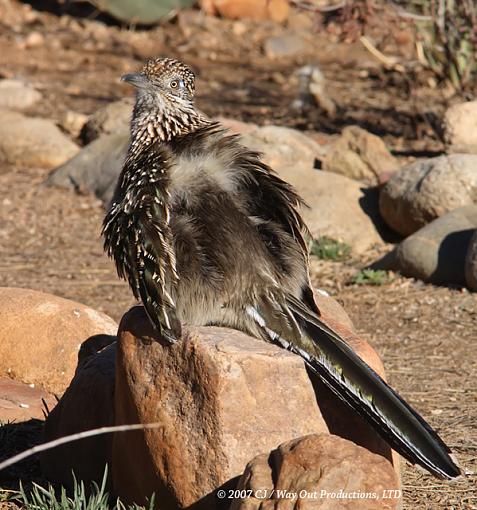CJ's Desert Dwellers: Greater Roadrunner Geococcyx californianus
This photo shows one of our four resident Greater Roadrunners Geococcyx californianus 'kick-starting' their metabolism. They open their outer feathers to reveal a large area of dark downy feathers that is a 'solar collector'. They know me and follow me about in the morning, waitiing for a handout of hamburger.
Length:575 mm (23 in)
Wingspan: 550 mm (22 in)
weight: 380 g (13 oz)
Family Cuculidae (cuckoos)
ID: NO SEXUAL DIMORPHISM Sexes look alike, with BOTH sexes having the distinctive orange and white facial stripes.They have a distinctive long tail, shaggy streaked feathers and a ragged crest that they raise and lower frequently.They also raise and lower their tail feathers in the same manner.
Voice: They have a lot of different vocalizations, including a nice 'coo' that slowly descends in pitch and presence. Often, the mating call is mistaken for a mourning dove. They clack their bill together in rapid succession, used as a call and as a territorial signal. (They are very territorial and mate for life. )
Uncommon, in dry open, bushy, grassy or deserrt habitats. These birds are carnivores, unlike the cartoon version. They eat bugs, lizards, small birds, rodents, small rabbits…if it moves, it's a target!!!
Voice: They have a lot of different vocalizations, including a nice 'coo' that slowly descends in pitch and presence. Often, the mating call is mistaken for a mourning dove.
Sources:
The Sibley Field Guide to Birds of Western North America
Petersens Guides: Western Birds
Audubon Society Field Guide to Birds of NorthAmerica - Western Region
Date Taken: 2007-02-05
Categories: Birds
Camera: Canon 400D Digital Rebel XTi, Canon Lens EF 300 mm 1:4 L IS, Canon Extender EF 1.4ex II, hoya 77mm HMC UV[O]
Exposure: f/16, 1/125 seconds
Handheld
Slight crop




 LinkBack URL
LinkBack URL About LinkBacks
About LinkBacks

 Reply With Quote
Reply With Quote